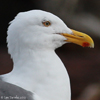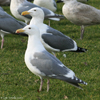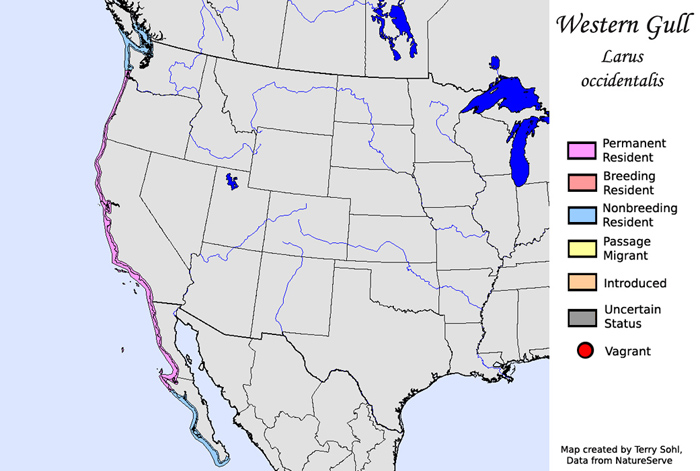|
||
Coordinators: 1cy June 2cy Jan 3cy Jan 4cy / sub-ad Jan adult Jan |
adult: FebruaryBelow you will find a description of Chapter 31 WESTERN GULL Larus occidentalis, as published in one of the best Gull publication: "Gulls of the Americas" by Steve Howell & Jon Dunn. "we" in the text below refers to the original authors. If any errors occur in this text, please let me know and mail to marsmuusseatgmaildotcom. PART 1 - summary and distribution (this page below) 31 WESTERN GULL Larus occidentalisLENGTH 21-26 IN. (53.5-66 cm) Identification summaryThis large, dark-backed, pink-legged gull is common along the U.S. Pacific Coast, where it is characteristic of the California Current coastal upwelling ecosystem. Heavily built and broad-winged (typically showing a skirt at rest). Bill typically stout and bulbous tipped, but relatively slender on some females; compared to Glaucous-winged Gull, bill of Western often looks shorter and more bulbous-tipped. At rest, tail tip about equal with or slightly shorter than tip of P7. Adult has slaty gray upperparts (Kodak 8-11, see Taxonomy) and reduced dusky head and neck streaking in basic plumage. Juvenal dark brownish overall with solidly blackish tail. PA1 starts Sept.-Nov. Subsequent ages variable in appearance. All ages have pink legs; adult eyes pale to dusky; orbital ring chrome yellow. No other large dark-backed gull occurs regularly in its range, so older immature and adult Western Gull normally distinctive by virtue of slaty gray upperparts and pink legs. Most similar species are Slaty-backed Gull (N. Pacific) and Yellow-footed Gull (Gulf of California). In first cycle also see Herring Gull, and note that hybrid Western X Glaucous-winged Gulls show various combinations of parental characters - and can also resemble other species (see hybrid account below). Taxonomy Two subspecies recognized, distinguished mainly by darkness of upperparts although southern birds average slightly smaller (see Bell 1996): Subspecies boundary not well known (see AOU 1957 & Roberson 2002), and tone of upperparts somewhat clinal (see Bell 1996): typical nominate occidentalis breeds from n. California south to San Mateo County (37-42° north), typical wymani from California Channel Is. south to n. Baja California Sur (27-34° north). Breeding birds in Monterey and San Luis Obispo counties (35-36.5° north) intermediate in upperpart tone (Kodak 9-10), whereas "Western Gulls” in Oregon and Washington paler above (Kodak 7-8) than typical occidentalis, perhaps reflecting introgression with Glaucous-winged Gull. (see Bell 1996) Northern occidentalis hybridizes commonly with Glaucous-winged Gull in Washington and Oregon (see Bell 1997; Hoffman et al. 1978 and Scott 1971), and some authors consider these taxa conspecific (see Weber 1981). Yellow-footed Gull of Mexico formerly considered a subspecies of Western Gull (see AOU 1957). Status and distribution W. N. America; accidental in Hawaii.
|
occidentalis Western Gull |
 Western Gull occidentalis C16 adult, February 14 2016, Stow Lake, CA. Picture: Rudyard. Western Gull occidentalis C16 adult, February 14 2016, Stow Lake, CA. Picture: Rudyard. |
||
 Western Gull occidentalis adult, February 23 2017, Pacific Grove, California, USA. Picture: John Cant. Western Gull occidentalis adult, February 23 2017, Pacific Grove, California, USA. Picture: John Cant. |
||
 Western Gull occidentalis adult, February 23 2017, Pacific Grove, California, USA. Picture: John Cant. Western Gull occidentalis adult, February 23 2017, Pacific Grove, California, USA. Picture: John Cant. |
||
 Western Gull occidentalis adult, February 23 2017, Pacific Grove, California, USA. Picture: John Cant. Western Gull occidentalis adult, February 23 2017, Pacific Grove, California, USA. Picture: John Cant. |
||
 Western Gull occidentalis adult, February 17 2009, Beaverton, Oregon. Picture: Greg Gillson. Western Gull occidentalis adult, February 17 2009, Beaverton, Oregon. Picture: Greg Gillson. |
||
 Western Gull occidentalis adult, February 14 2009, Portland, Oregon. Picture: Lyn Topinka. Western Gull occidentalis adult, February 14 2009, Portland, Oregon. Picture: Lyn Topinka. |
||
 Western Gull occidentalis adult, February 09 2012, Seaside Cove, Oregon. Picture: Lyn Topinka. Western Gull occidentalis adult, February 09 2012, Seaside Cove, Oregon. Picture: Lyn Topinka. |
||
 Western Gull occidentalis adult, February 09 2012, Seaside Cove, Oregon. Picture: Lyn Topinka. Western Gull occidentalis adult, February 09 2012, Seaside Cove, Oregon. Picture: Lyn Topinka. |
||
 Western Gull occidentalis adult, February 17 2009, Beaverton, Oregon. Picture: Greg Gillson. Western Gull occidentalis adult, February 17 2009, Beaverton, Oregon. Picture: Greg Gillson. |
||
 (Crystal Cove).jpg) Western Gull occidentalis adult, February 02 2006, Crystal Cove, Orange Co. Picture: John Avise. Western Gull occidentalis adult, February 02 2006, Crystal Cove, Orange Co. Picture: John Avise. |
||
 Western Gull occidentalis adult, February 14 2009, Portland, Oregon. Picture: Lyn Topinka. Western Gull occidentalis adult, February 14 2009, Portland, Oregon. Picture: Lyn Topinka. |
||
 Western Gull occidentalis adult, February 14 2009, Portland, Oregon. Picture: Lyn Topinka. With Olympic Gull. Western Gull occidentalis adult, February 14 2009, Portland, Oregon. Picture: Lyn Topinka. With Olympic Gull. |
||
 Western Gull occidentalis
Western Gull occidentalis
